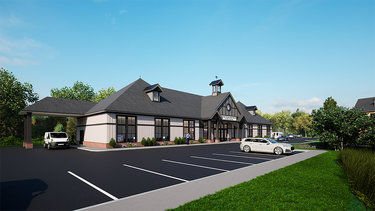Thomas to challenge village parking requirement for proposed development
ALTAMONT — Jeff Thomas is challenging Code Enforcement Officer Gary Goss’s ruling that Thomas’s proposed village center development is out of compliance with village parking requirements.
The Altamont Zoning Board Appeals has set a June 17 public hearing on the matter.
Thomas was told he would need multiple variances for the project to gain approval, but appears to be challenging Goss on his parking determination because, as Thomas sees it, Goss’s math is incorrect.
Work on the 1.86 acre parcel would include demolition of two existing buildings, the village post office, and another on the site, to be replaced with:
— A 6,000-square-foot post-office building;
— A 4,200-square-foot, two-and-a-half-story mixed-use building with commercial space and six residential units;
— A two-story building with six residential units; and
— A 1,200-square-foot community center.
For his current proposal, Thomas told board members he was approached three to four years ago by the post office about needing more space — Thomas is the owner of the 108 Park Street post-office building.
The current building is about 2,700 square feet; the plan is to more than double that space, to 6,000 square feet.
The site for the proposed enlarged post office is the current home of Altamont’s post office, a fire-suppression company, and a historic rail-station building.
While parking compliance may be low on the list of project priorities — given, for example, village code doesn’t actually allow for the type of development that is being proposed in the central business district — the parking issue is currently holding up the project. It was explained to board members on May 27 that the village code dictates that, when an appeal like Thomas’s is filed, all other project activity comes to a grinding halt until, in this instance, the zoning board weighs in on the parking issue.
“The question of whether the mixed-use development that the applicant was proposing is permitted in this district arose, which led to an interpretation by our code-enforcement officer that the use was not, in fact, permitted in this location,” village attorney Allyson Phillips told board members on May 27. “In addition, he reviewed the special-use permit application and made three other determinations relevant to whether or not certain setbacks would require a variance under our code and also whether the amount of parking that was provided as part of the project met our code requirements.”
So, even though Goss raised a fundamental question about the proposed use at the Park Street location, the zoning board has to effectively sit on its collective hands and wait to debate those issues, because the board can only move forward after it makes a decision on the Thomas appeal, something akin to “putting the cart before the horse,” Phillips explained.
History
Thomas first came to the village in 2018 with a proposal to build three stand-alone buildings containing 26 apartments at 120 Park Street, adjacent to the Altamont Free Library and behind the post office.
Board members at the time cited issues with traffic, water and sewer, and stormwater management, among others. While the project attorney told the board in 2018 that Thomas would not seek a variance for the housing — rather, the village code-enforcement officer would be asked for a determination about the proposed development’s compliance with existing zoning.
The project went away quietly soon after.
Thomas was back before the board last November with his latest proposal, only to hear criticism similar to that of his 2018 experience. This time around, board members were once again citing concerns over traffic, parking, environment, and that the project isn't allowed to be built where Thomas is proposing.
Goss’s analysis
As for Goss, his analysis of the project based on the village’s zoning code arrived at several conclusions, strengthening board members’ earlier observations, among them:
— The project, at its proposed location, is not permitted under current zoning.
An issue since the project was first introduced in 2018 has been that the Park Street location in the village’s Central Business District doesn’t allow for stand-alone multi-family housing.
During earlier meetings, members of the Thomas development team said there was language in the village’s density control schedule, which outlines parameters for lot sizes and building dimension, that references mixed-use buildings, which suggested that the code, while perhaps ambiguous, did provide a basis for the proposed development.
Donald Cropsey, once the village’s code-enforcement officer, argued that the inclusion of the mixed-use terminology in the density control schedule indicated an intention to accommodate such projects in the Central Business District, but acknowledged that “the rest of the zoning law is silent on mixed-use buildings.”
Phillips on May 27 explained, “Because of the way our code is set up, we have to consider this appeal first, and then the applicant has other available remedies if they want to pursue the project, which would require an amendment to our zoning law, which they have to go to the village board for”;
— The project doesn’t meet certain setback requirements.
Thomas would need an area variance from the 50-yard setback required of rear property lines, as the multifamily building and the entire new post office would be within the setback; and
— The proposal, according to village code, doesn’t provide sufficient parking.
Later this month, the board will decide whose math is correct when it comes to calculating the number of parking spaces required for the project.
Thomas had earlier argued that the number of non-post office parking spaces he was providing, 53, was more than the code-required 48, but claimed Goss had been rounding up the required one-and-a-half parking spaces per multi-family living unit to two prior to completing his calculation, which resulted in a higher parking requirement.
Board member Charles Trout on May 27 sought clarification on the calculation. “It seems like the question is whether you round 1.5 to 2 at the beginning or the end of the calculation,” Trout observed.
Phillips, while stating she didn’t want to “put too many words in Gary’s mouth,” said that, “yes,” it was her understanding that the rounding up was “part of Gary's determination.”
She said, “When looking at the code and doing the calculations, taking the square footage and the number of spaces that would then be required by the code, if you come out with a half number, it’s Gary’s interpretation that you need to round up because that needs to be a fully provided parking space.”
Phillips continued, “And, when he uses that methodology, you know, specifically with regard to the post-office building and then using those calculations also for the mixed-use and the residential building, he does come out with a larger number of required spaces.”



